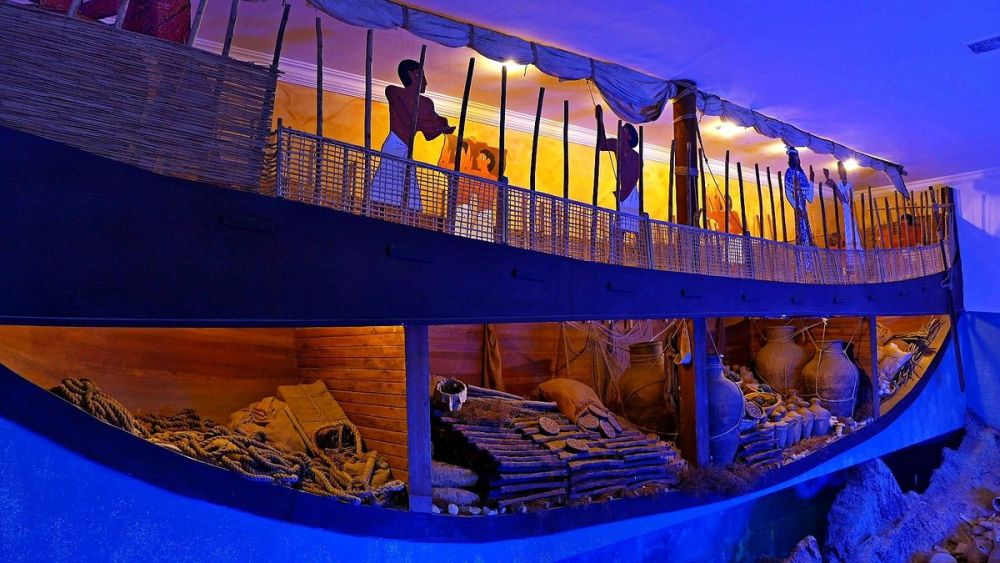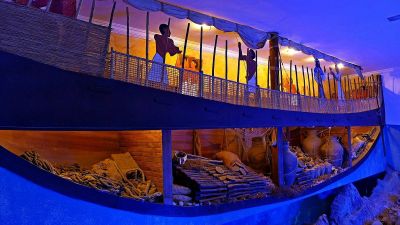

The Glass Shipwreck Hall within the Bodrum Museum of Underwater Archaeology showcases one of the most extraordinary collections of ancient glassware recovered from shipwrecks in the Aegean Sea. Visitors can marvel at the extensive array of artifacts dating back to the 16th century BCE, offering a unique insight into the trade and daily life of past civilizations. The exhibition not only displays the cargo of a 14th-century BCE shipwreck but also provides detailed information on the methods used by underwater archaeologists to recover and preserve these historic treasures. Interactive screens and reconstructions help bring the story of the shipwreck to life, making it a spellbinding experience for history enthusiasts and families alike.
Dive into history with the Uluburun Shipwreck Exhibition at the Bodrum Museum of Underwater Archaeology. This world-renowned exhibit gives an in-depth look at one of the oldest and most significant maritime discoveries: the Uluburun shipwreck, dating back to the 14th century BCE. Visitors can explore an array of preserved artifacts, including precious metals, exotic raw materials, and unique items that throw light on the vast network of trade during the Late Bronze Age. The highlight is the reconstructed ship that provides an immersive experience. Informative panels and audiovisual aids narrate the ship's history, the excavation process, and the conservation efforts required to maintain this precious link to our past.
The Medieval Shipwreck Exhibition at the Bodrum Museum is an enthralling display that draws visitors into the maritime history of the Middle Ages. The exhibit features remnants of a 7th-century shipwreck, which gives insight into Byzantine-era sailing and trade. Artifacts on display include amphorae, pottery, and everyday items that were part of the ship's cargo, painting a vivid picture of life and commerce in that historical period. Expertly curated information boards guide visitors through the significance of the finds and provide context about the era's political and cultural environment. The exhibit is a must-visit for those intrigued by history and the development of seafaring through the ages.
The Tower of the English exhibition is housed in one of the Bodrum Castle's most iconic towers, named after the English knights who once managed it. This exhibit offers a fascinating glimpse into the world of underwater discoveries from the Ottoman period. On display are a variety of objects that include ceramics, coins, and personal belongings salvaged from shipwrecks around the Bodrum peninsula, which highlight the rich cultural heritage and historical significance of the region during the Ottoman era. Visitors are treated to not just a view of the historical artifacts but also the panoramic vistas of Bodrum from the top of the tower.
Step back into the time of the Carian civilization with a visit to The Carian Princess Hall, a revealing exhibition dedicated to an ancient Carian princess's tomb discovered in the region. The exhibit showcases remarkable finds such as intricately crafted jewelry, ornate pottery, and the sarcophagus of the princess. The hall engrosses visitors in the grandeur and customs of the Carian people through the displayed artifacts, which are accompanied by detailed descriptions and historical background. The exhibit educates on burial rites, social hierarchies, and the role of women in Carian society, making it an enlightening experience for those eager to understand the region's ancient history.
The Amphora Exhibition at the Bodrum Museum is a trove of historical knowledge, focusing on the amphorae used by ancient civilizations for the storage and transport of goods like oil, wine, and grains. These ceramic vessels are key in understanding the trade practices and daily life of the time. The museum boasts a wide variety of amphorae, each with its own story. Informative plaques explain the uses, origins, and manufacturing techniques of the amphorae, and visitors can learn about the different types and shapes that were specific to particular regions and time periods. The collection is beautifully displayed and provides a fascinating glimpse into the workings of the ancient economy.
The Eastern Mediterranean Shipwreck Exhibition delves into the multicultural and vibrant sea trade that transpired in the Eastern Mediterranean region. It features shipwreck remains and cargoes, including Greek, Roman, and Byzantine vessels that traversed the Aegean and Mediterranean Seas. Visitors can engage with the narratives of these ancient mariners through a wide variety of artifacts on display, which include beautifully preserved ceramics, glass works, and tools. The display is educational, illustrating how the sea was a conduit for cultural exchange and how these maritime routes contributed to the economic and political landscapes of the time. The exhibition is an eye-opener for those drawn to maritime archaeology and the historical links between civilizations.
At the Ancient Shipbuilding and Navigation Exhibition, visitors gain a deep perspective on the ingenuity and skills of ancient shipbuilders and navigators. The exhibition features various artifacts, scale models, and reconstructions that give insights into the evolution of shipbuilding techniques from the Bronze Age to the Byzantine period. This includes the types of tools used, the materials chosen for construction, and the ingenious designs that allowed these ancient cultures to explore and trade across the seas with remarkable efficiency. The exhibit also sheds light on the navigational instruments and methods used to traverse the vast openness of the seas. It's a compelling experience for those looking to appreciate the technical prowess and the adventurous spirit of ancient mariners.
Explore the opulent past in the Coin and Jewelry Hall, where a dazzling collection of ancient coins and magnificent jewelry awaits visitors. The extensive selection represents various time periods, including Hellenistic, Roman, Byzantine, and Ottoman eras, indicating the rich history of Bodrum and its surroundings. Each piece is meticulously displayed, with detailed information on their historical and cultural contexts. For numismatics enthusiasts, the coins provide a narrative of economic history, the spread of empires, and artistic trends. The jewelry, carefully crafted and ornate, reflects the artistry and status symbols of the civilizations. This exhibition promises an enchanting look at the treasures that were valued by ancient peoples.
For an immersive and educational experience, visitors can embark on a Guided Museum Tour led by knowledgeable guides who bring the past to life with stories and facts about the Bodrum Museum's displays. The tour includes visits to the museum's most captivating exhibits, offering insights into the Uluburun Shipwreck, the English Tower, the Carian Princess Hall, and much more. This comprehensive tour is perfect for history buffs and casual explorers alike, as it covers the evolution of underwater archaeology and its impact on our knowledge of ancient civilizations. The guides' expertise provides depth to the visitor experience, with anecdotes and explanations that are not available through standard exhibit labels.
